Cyber Shadow is a retro action platformer that starts out inspired by 8-bit ninja videogames, particularly Ninja Gaiden, but forges its own identity over time as I unlock its unique movement abilities. The player character is Shadow, a new member of a ninja clan sworn to protect the future metropolis Mekacity. The plot kicks off when Shadow is consumed by a massive explosion at the city’s heart. He barely survives, his ruined body rebuilt using cybernetic technology. While Shadow recovers in stasis, Mekacity descends into chaos as the synthetic humanoids that once served it go berserk. With his ninja clan’s members falling one by one, Shadow is awakened early and given the desperate charge of stopping the synthetic army despite his weakened state.
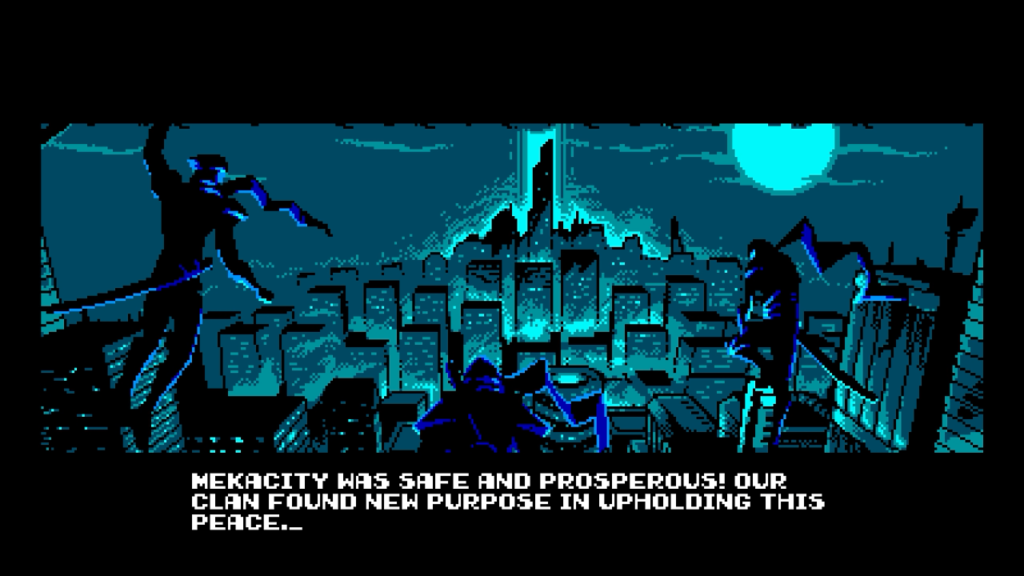
To help Shadow avenge his clan, I must guide him from Mekacity’s secret depths to its shattered heights across eleven stages. Each stage feels distinct. In the Disposal Facility, I can slash cubes of recycled metal out of Shadow’s way, or climb on top of them to reach high platforms. In the Reactor, energized orbs spill from shattered machinery, briefly electrifying water or platforms they make contact with. In the Return to Mekacity, Shadow rides a talking motorcycle at breakneck speeds along a broken highway while menaced by hostile synthetics and floating landmines. Cyber Shadow’s level design does what any good action platformer should: Building unique scenarios onto basic mechanics to make each level distinct.
Platforming is further complicated by Shadow’s ever-expanding ninja abilities. When he first emerges from stasis he has a rudimentary platforming skillset, allowing me to jump and attack with his sword. At the end of most levels, Shadow absorbs a new ability from one of his fallen clanmates. He first learns to throw ninja stars, then to launch flames directly above him, each useful for dealing with inconveniently ranged foes provided I have enough spirit power to use the abilities.
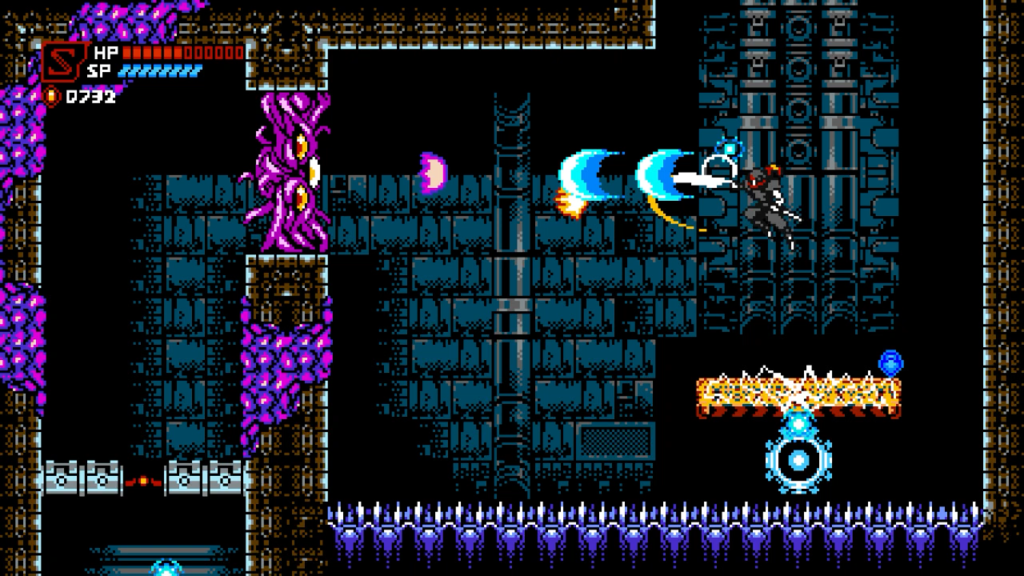
Shadow also learns to parry enemy projectiles, in a sense. If I press the d-pad in the direction of a projectile with pixel-perfect timing, it will turn into an energy ball which I can attack to launch it across the screen. This deals incredible damage to any enemies that get in its way. I appreciate the level of skill parrying takes; if I press the d-pad too soon or too late I will walk into the projectile instead of parry it. But I would prefer for Cyber Shadow to more fully utilize the gamepad. All actions are relegated to either the jump or attack buttons combined with a direction on the d-pad. The counter would be easier to perform if it was assigned to one of the gamepad’s many unused buttons instead of sticking rigidly to its two-button, 8-bit inspirations.
Not all of Shadow’s skills are elective. His skills I use most are the Airstrike, a midair thrust downward that can propel Shadow off an enemy or container, and the Sprint Attack, an attack that propels Shadow across the screen with a flash. Both these abilities may be used multiple times in a row if they strike a target and also refresh Shadow’s double jump, creating situations where applying them skillfully can cut corners through challenging platforming sections.
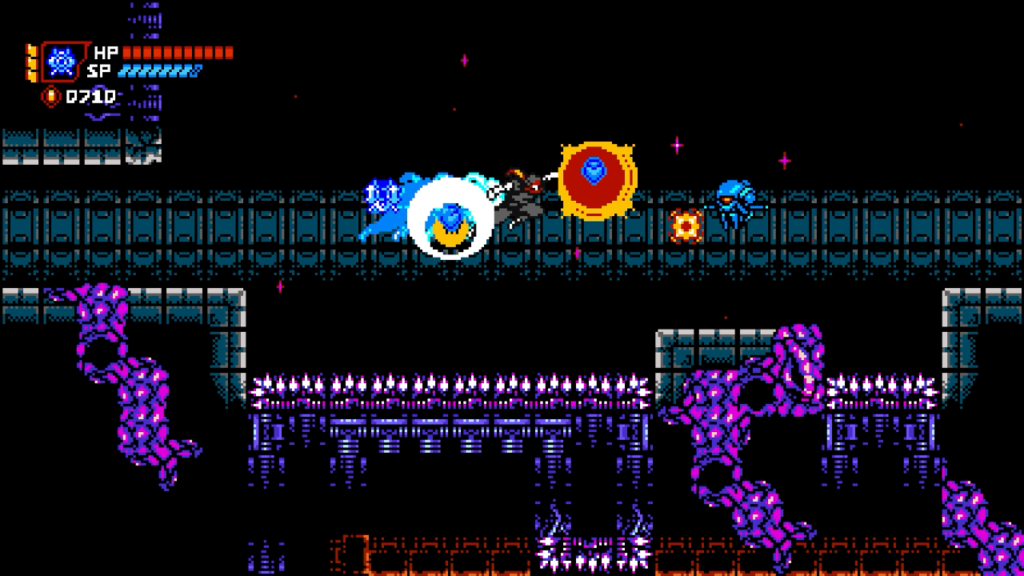
Cyber Shadow begins with straightforward platforming of little difficulty, but that difficulty rises steadily throughout. Later levels are designed to be cavorted through with chained Airstrikes and Sprint Attacks. While I can see these paths, I am unable to follow them, my failure typically punished with an instant-death pit. In spite of Cyber Shadow’s 8-bit inspirations, the Airstrike behaves like no other downthrust I have ever experienced and often feels unintuitive to use. The Sprint Attack requires not only precise timing but also optimal placement from multiple moving targets. Many of Cyber Shadow’s most aggravating sections see me taking the slow path through a gauntlet whose quick path I can see but is tantalizingly beyond my skill to follow.
Cyber Shadow does offer me some elective difficulty through its hidden upgrades. I can break down certain walls to discover obstacle courses whose completion rewards me with upgrades for Shadow’s hit points or spirit power. Most of these upgrades are accessible on my first encounter, but some require me to revisit the level with an ability learned later in Shadow’s journey. My diligence in discovering these upgrades and determination in earning them can make later challenges much easier to overcome.
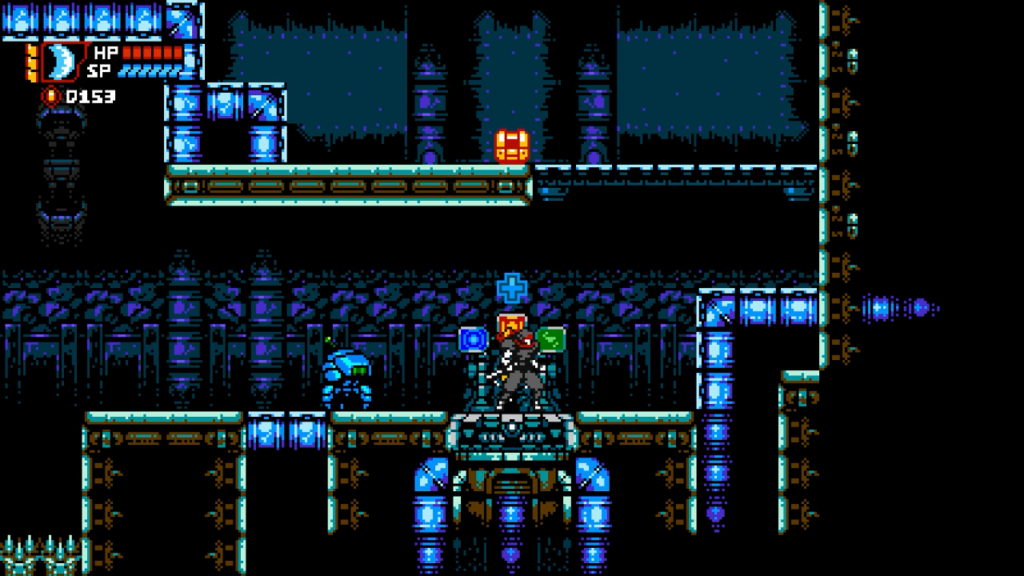
I also experience elective difficulty with Cyber Shadow’s checkpoints. As I run through levels with Shadow, he picks up “essence” from smashed containers and defeated enemies. Essence can be spent at a checkpoint to increase its restorative capabilities. I can spend some essence to make a checkpoint restore all of Shadow’s hit points, a little more to also restore his spirit points, and still more to create a temporary powerup that increases Shadow’s attack capabilities. I make the effort to gather as much essence as I can and always seem to have enough on hand to fully upgrade every checkpoint, but if I wanted more of a challenge I could choose not to spend essence and struggle through Shadow’s quest only using pickups from enemies to restore his health.
As difficult as Cyber Shadow’s platforming challenges become in its latter half, its smart use of elective difficulty modifiers leaves me with a sense of control over my experience. It also wisely dispenses with the outdated concept of extra lives; I can keep retrying from my last checkpoint as often as needed. Several sections take me many, many attempts.
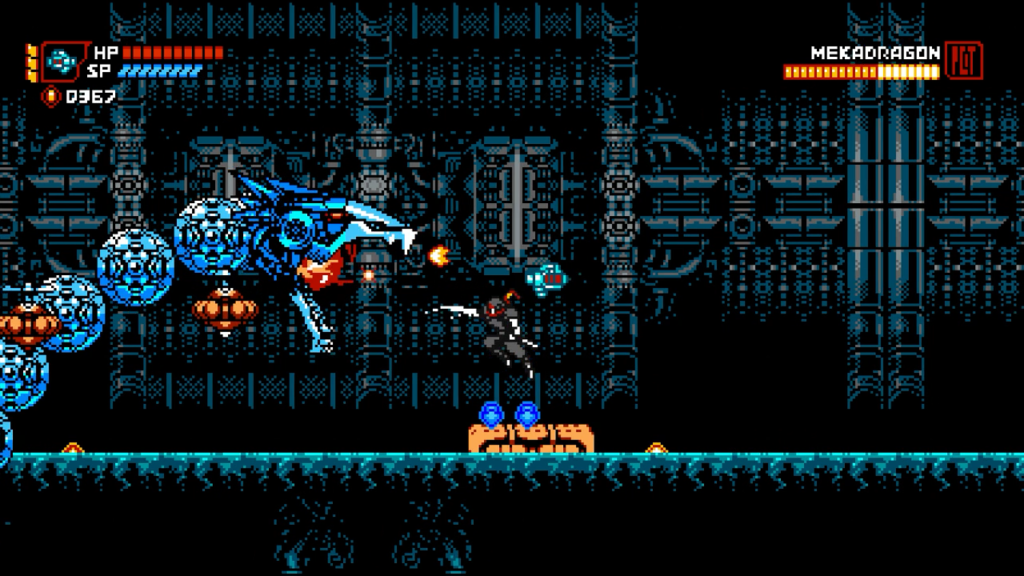
Where Cyber Shadow’s difficulty feels moderate is its bosses. Like the levels they cap off, each offers a distinct spin on basic action mechanics. Some are one-on-one duels with other cyberninjas, like a duel in the rain with the Biohunter, a flying cyborg who bombards the rooftop battlefield with telegraphed rockets and a satellite laser. Others are technological spins of the giant monsters encountered in more traditional ninja platformers. The Mekadragon is the most memorable, a giant serpent fought in an open sewer where I must knock drones out of the air to use as makeshift rafts to avoid becoming easy prey in the putrid waters. Still others are literally part of the environment, including Subject Alpha, a failed experiment bonded to the walls of a lab who turns the floor beneath Shadow into a disgusting, pulsating weapon. No single boss feels similar to another except that they punish recklessness. A focus on careful, defensive play instead of harried, offensive play makes most bosses beatable for me in two or three attempts.
Cyber Shadow is overall a difficult platformer but that difficulty is tempered by efficient design. It’s not an easy videogame to finish, but it is easy to understand. I’m never confused by what I need to accomplish on the current screen. I only wish that efficiency was also applied to the story.
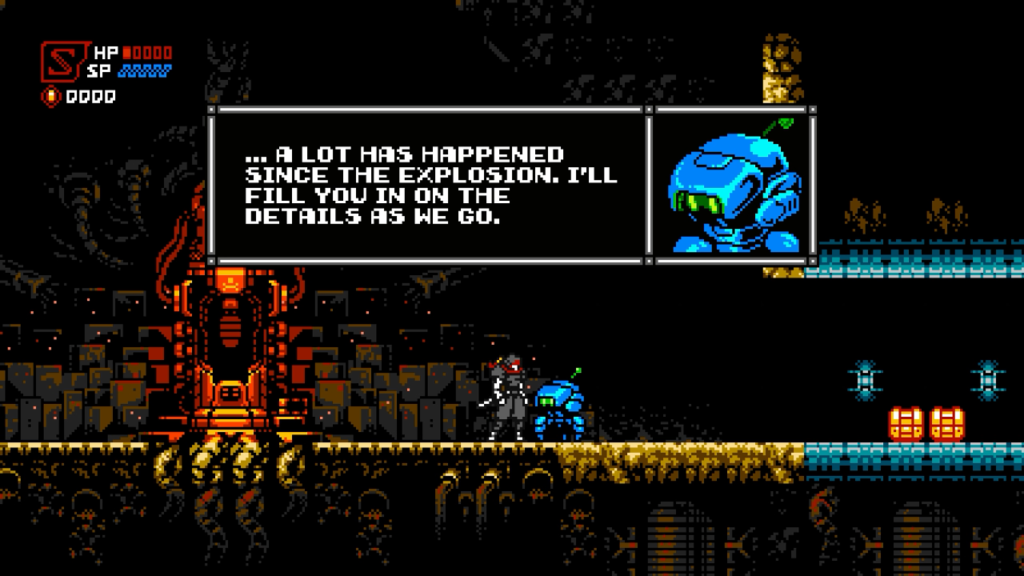
Cyber Shadow’s story isn’t just about Shadow avenging his hunted clan. It’s also the story of Shadow’s love for The Master, his clan’s leader. It’s the story of Shadow’s conflict with Apparitor, a more experienced rival ninja. It’s the story of three elemental spirits and their search for the missing fourth. It’s the story of a mechanical genius and the extremes he will take his talents to save his daughter’s life.
It also asks philosophical questions. When does a society become too reliant on its technology? Who wards a culture against its technological progress, and what happens when those wardens fail? What makes a person “real?” Is their essence lessened when their body is replaced by technology? Is a copy just as genuine as the original, or a cheap imitation?
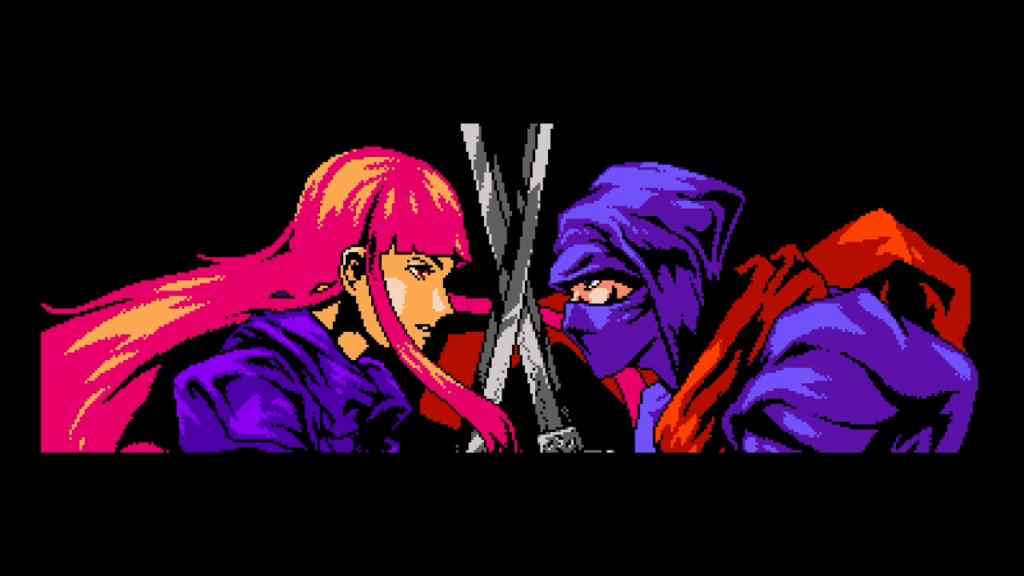
Shadow and Mekacity exist in a rich world and none of its details are bad by themselves, but an eleven-levels-long retro platformer doesn’t create enough space to explore all of it. Every relationship introduced and every question asked feels overstuffed into a genre that can’t support their scale. It tells a complete story with a beginning, a middle, and an ending, but I wish more time was spent focusing on a single idea so I will have a stronger reaction to that complete story. When I think about the end of Shadow’s journey, I feel nothing.
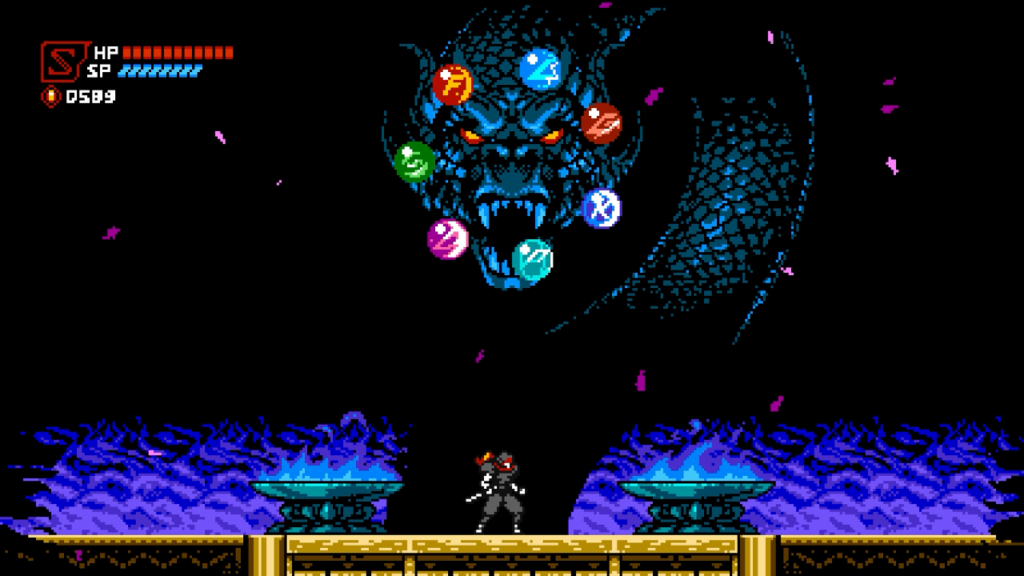
Cyber Shadow is a competent retro platformer that will challenge and delight experienced genre fans. Shadow’s skillset is just broad enough to have a useful skill for every situation, but the pace these skills unlock gives the first levels a misleading impression of its overall difficulty. The last few levels pull no punches and I discourage players who can’t take a relentless gauntlet in their stride from diving into Shadow’s adventure. I am most disappointed by its story. Its grandeur is let down by a length too short to contain everything it wants to say. I recommend Cyber Shadow most to challenge-minded players, particularly those who revel in playing and re-playing a videogame to master its intricacies.